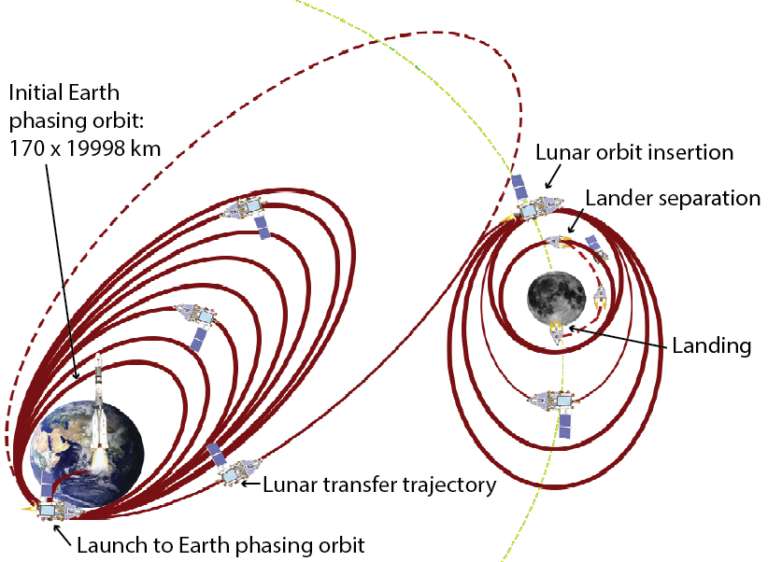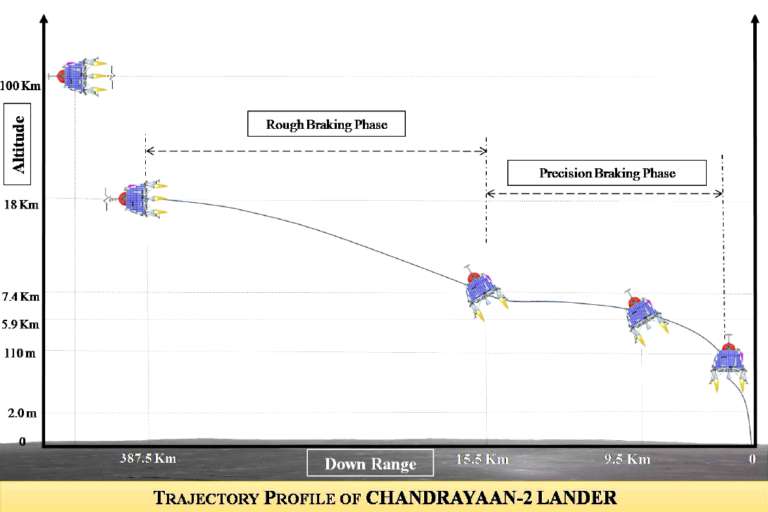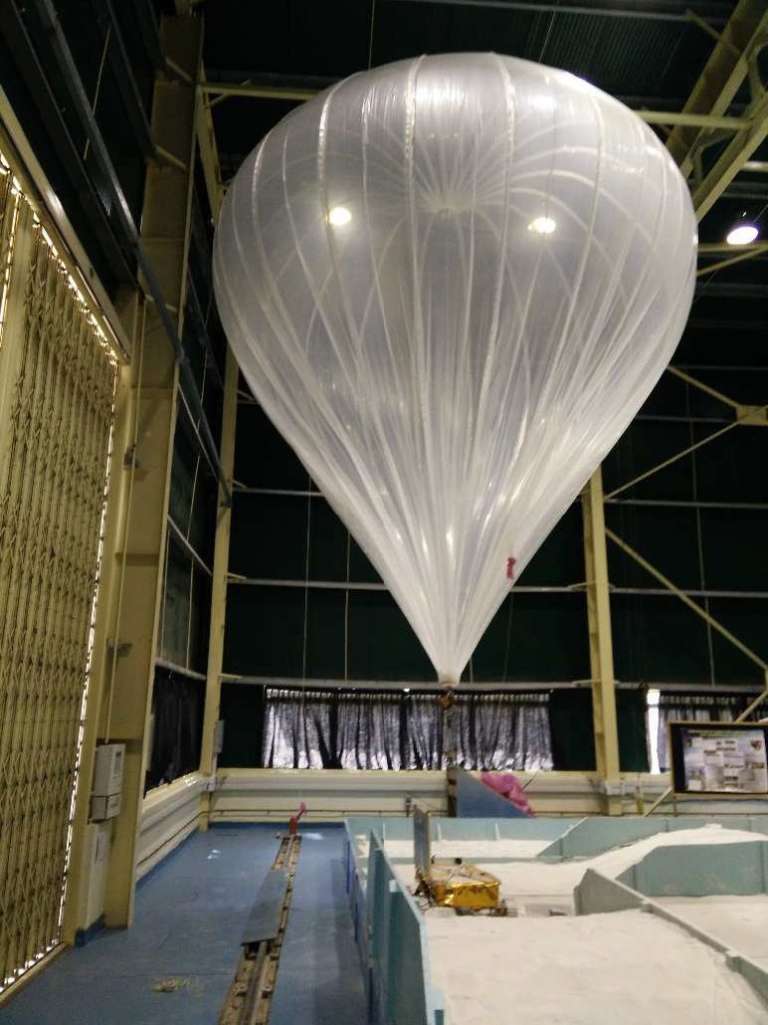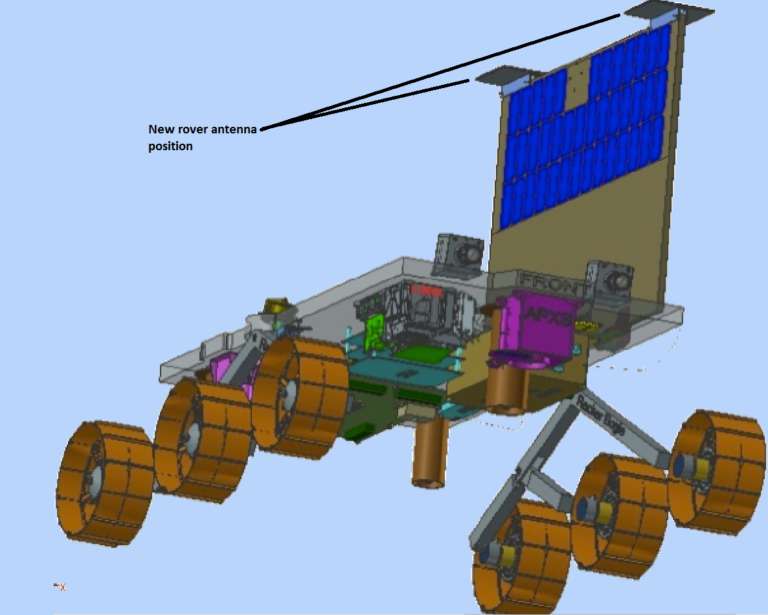Emily Lakdawalla • Nov 29, 2017
India's Chandrayaan-2 mission preparing for March 2018 launch
The launch of the next Moon mission could be just four months away. India plans to return to the Moon in a big way with the ambitious Chandrayaan-2, which includes an orbiter, lander, and a small rover. If it all succeeds, it will be India's first soft landing on another world, and only the second such landing since the end of the Apollo and Luna era. For India, landing success would be "a stepping stone for future exploration missions to other planets," according to Indian Space Research Organisation Satellite Centre (ISAC) director M. Annadurai.
The orbiter is a capable one, planned to carry eight instruments into a 100-kilometer, circular, polar lunar orbit, following on the work of India's previous orbiter, Chandrayaan-1. It has a nominal mission lifetime of one year. The lander and rover payloads are more limited, as befits the first demonstration of a soft lander. The lander and rover have nominal lifetimes of one lunar daytime (14 Earth days). I was unable to find any information on whether there is any possibility that the lander or rover could wake up again after the long lunar night, as China's Chang'e 3 lander has done for years. It's enough to hope that India can follow its first and only lunar orbiter with its first lunar lander.
Mission Profile
Chandrayaan-2 is planned to launch in March from ISRO's Sriharikota launch center aboard a Geosynchronous Satellite Launch Vehicle Mark 2 (GSLV Mk 2) rocket, making it ISRO's first deep-space launch on its newer, heavier launch vehicle. The combined mass of the three component spacecraft is 3250 kilograms, dramatically larger than the approximately 1300-kilogram mass of both Chandrayaan-1 and Mars Orbiter Mission, both of which launched on smaller Polar Satellite Launch Vehicles (PSLVs). (For fun, you can download and build a paper model of the GSLV Mk 2 spacecraft here.)
The GSLV will place Chandrayaan-2 into an elliptical Earth parking orbit, enlarging it over days or weeks with periapsis burns to raise the orbit apogee. Eventually, the apogee will be high enough that a burn can send the spacecraft on to a lunar transfer trajectory. A lunar orbit insertion burn will place Chandrayaan-2 into an elliptical orbit and the spacecraft will begin braking at periapsis to reduce its orbit to a 100-kilometer circle. I haven't found a reference that says how long this process is expected to take from launch to final orbit, but a similar process took Chandrayaan-1 three weeks, from October 22 to November 12, 2008.

Once the spacecraft is in its science orbit at the Moon, the lander mission can begin. While the orbiter doesn't care much about what phase the Moon is in, the lander and rover need sunlight for warmth and power, so the timing of launch will be dictated by the necessity to get the lander on the ground at its landing site very soon after local dawn. However, the concept of dawn is a bit tricky, because the landing site is planned to be near the south pole. I haven't seen any recent information on the specific landing site choice. As of 2012, an earlier concept that involved Russian collaboration had proposed landing sites that were quite near the South Pole indeed, at 87.2 and 88.5 degrees south.
The landing will happen entirely autonomously. The lander will separate from the orbiter and immediately perform a deboost maneuver, changing its orbit around the Moon to one with an 18-kilometer periapsis. When it reaches periapsis, the lander will begin the "rough braking phase," braking to reduce its orbit altitude to 7 kilometers.
At an altitude of 7 kilometers, the lander will use a camera to take photos of the lunar surface and determine its relative position and velocity compared to its onboard map of the landing region. The lander will autonomously determine the trajectory necessary to bring it to its desired landing site, and steer itself to a location 100 meters above the site, where it will come to a hover. It will use a hazard avoidance sensor to map the surface for potential hazards and select a safe location for touchdown. The lander will slowly descend until it reaches 2 meters above that location. Then it will cut its engines. The lander will fall to the surface, its four lander legs absorbing the shock of landing. The rover will roll out of the lander shortly after the landing in order to make the most of its brief, two-week primary mission.

Orbiter
The orbiter is physically similar to Chandrayaan-1. It is three-axis stabilized with reaction wheels. The orbiter carries five science instruments and two supporting instruments.
- Terrain Mapping Camera 2 (TMC-2) is based upon TMC (a predecessor on Chandrayaan-1) and will perform 3D mapping of the lunar surface using two cameras.
- Collimated Large Array Soft X-ray Spectrometer (CLASS) is based upon C1XS (a predecessor on Chandrayaan-1) and will map abundance of major rock-forming elements on the Moon including Mg, Al, Si, Ca, Ti, and Fe. Assisting it is the Solar X-ray Monitor (XSM), which measures solar x-ray emission.
- Chandra's Atmospheric Composition Explorer(ChACE-2) is a neutral mass spectrometer that is based upon CHACE (a predecessor on Chandrayaan-1's Moon Impact Probe).
- Synthetic Aperture Radar (SAR) will perform radar mapping of the surface in both L and S bands of the radio spectrum. It has heritage from MiniSAR on Chandrayaan-1 but will be the first L-band radar mapper to orbit the Moon.
- Imaging Infra-Red Spectrometer (IIRS) is sensitive to light with wavelengths between 0.8 and 5 microns and has the specific goal of mapping the abundance of hydroxl ions and molecular water.
- Finally, the Orbiter High Resolution Camera (OHRC) will perform high-resolution imaging of the landing site prior to the lander mission.

Lander
Physically, the lander is shaped like a truncated square-based pyramid, built around a cylinder that houses the substantial propellant tank. It will perform inertial navigation throughout the descent using its Laser-gyro-based inertial reference unit and accelerometer package, LIRAP. The propulsion system includes four throttleable engines that can each provide 800 newtons of thrust, and 8 attitude rockets of 50 newtons each. The lander will communicate direct to Earth using a steerable, dual-gimbal, S-band radio antenna.
The lander has multiple cameras in its Hazard Detection and Avoidance (HDA) system, which it will use to determine horizontal velocity from feature tracking and identify the landing site using pattern matching. HDA also contains microwave and laser altimeters and a laser Doppler velocimiter. The HDA system collects data and instructs the rockets to fire to steer the lander to the landing site. I didn't find any reference that indicated whether the lander has the ability to photograph the landscape it's sitting on. Surely it must, but I don't know.
Once on the ground, the lander will deploy its science payload:
- Instrument for Lunar Seismic Activity (ILSA) will study moonquakes. Large enough quakes could allow it to study the Moon's deep interior, potentially from a polar position not accessible to the Apollo seismometers, which would be cool. This experiment will be a lot cooler if the lander is capable of surviving multiple lunar days.
- Chandra’s Surface Thermophysical Experiment (ChaSTE) will measure thermal properties of the lunar surface.
- Radio Anatomy of Moon Bound Hypersensitive ionosphere and Atmosphere (RAMBHA-Langmuir Probe) will measure near surface plasma density and how it changes over the course of the lunar daytime. According to a recent Nature article, lunar plasma is thought to participate in the levitation of lunar dust, a problem for future human exploration.
And, of course, the lander will carry a rover. The rover is very small, roughly Sojourner-sized, at 20 kilograms. Like NASA's Mars rovers, the Chandrayaan-2 rover uses a rocker-bogie suspension system supporting six independently motorized wheels, but unlike NASA's rovers its corner wheels do not steer. Therefore, it steers by rotating the wheels at different rates, like a tank. This is a perfectly fine method for a lightweight rover as long as the net effect of steering isn't to sink the rover into the soil.
To make sure the rover could move and steer on the Moon without embedding, ISRO developed a big sandbox filled with crushed anorthosite to test rover mobility in. When NASA does this with Mars rovers, they build full-size mobility system mockups with tiny bodies so the whole vehicle weighs on Earth what the real rover weighs on Mars, where gravity is a third of Earth's. But that wouldn't work for the already-small Chandrayaan-2 rover trying to simulate lunar gravity at a sixth of Earth's. So ISRO developed a different solution that I just love: attaching a giant helium-filled balloon to a duplicate test rover to counterbalance 5/6 of its weight. These tests succeeded, evidently.

Because of its small size, the rover instrumentation is fairly limited, much like Sojourner's was. It has two navigation cameras for stereo path planning and an inclinometer for safety (drives will stop if the rover's inclination or motor current gets too high). It has no rear-facing cameras. It will use a small radio antenna for communication with the lander, which will relay rover data to Earth. The radio antenna is atop its vertically-mounted solar panel. Its solar panel is mounted vertically because of the near-polar landing site. That suggests the rover will need to turn in place after traverses to align the panel for good power production.
The rover is equipped with two science instruments for elemental composition, both of which point downward, beneath the rover: a Laser-Induced Breakdown Spectroscope (LIBS) and an Alpha Particle X-Ray Spectrometer. In general, LIBS will get you lower-mass elements and APXS will get you higher-mass elements, with substantial overlap between them. LIBS is faster, APXS more sensitive to trace elements if you can give it long enough integration time. Perhaps they will be using LIBS along traverses, and APXS at stops.
Interestingly, a paper I read about the LIBS instrument suggested it was designed for a one-year primary mission. Officially, the lander mission has an expected lifetime of 14 days, but maybe there is hope that it will survive a lunar night to do science on a second lunar day. That would be awesome. But any successful landing at all would be an enormous accomplishment for India; I don't want to get greedy.

Looking Ahead
Originally, Chandrayaan-2 was supposed to be a collaboration with the Russian space agency, but budget problems made Russia drop out, and India decided to go it alone. If Chandrayaan-2 succeeds, India's next step will be lunar sample return. They'd be following exactly the same path China has at the Moon, going quickly from a successful orbiter, to a lander/rover, to autonomous sample return. Unlike China, however, India is using international collaboration to increase its chances for success; Indian prime minister Narendra Modi and his Japanese counterpart Shinzo Abe signed an agreement a couple of weeks ago to collaborate on a future joint lunar sample return mission.
A lot of people are trying to make the separate Chinese and Japanese/Indian lunar efforts into a race. To be sure, there is some national pride riding on successes in space, and reaching milestones first. But races have only one winner. We all win when more organizations launch scientific missions into space. All of these countries have shared the data they gathered during past missions with scientists and the public. India's mission landing near the south pole, and China's landing on farside, will only enhance global understanding of the Moon, regardless of who gets there first. India or China may yet be defeated by physics -- deep-space exploration is challenging -- but they won't be defeated by each other's success.
Good luck, saubhaagy to ISRO and India on the upcoming launch of Chandrayaan-2!
References
Many thanks to Sriram Bhiravarasu for providing me some papers I used as sources for this article.
Annadurai M (2017) "Future Exploration Missions of ISRO" presentation to the 60th session of the United Nations Committee on Peaceful Exploration of Outer Space, 7-16 June 2017, Vienna, Austria
Annadurai M et al (2017) "Chandrayaan-2 lunar orbiter & lander mission" abstract presented to the 10th IAA Symposium on the Future of Space Exploration: Towards the Moon Village and Beyond, 27-29 June 2017, Torino, Italy
Further reading
See everything I've written or edited about Chandrayaan-2 here.
An enthusiast website about Chandrayaan-2 maintained by Vijainder K Thakur is full of useful information, most of it with sources, though sources aren't linked.
Also useful to follow are Chandrayaan-2 threads at nasaspaceflight.com and unmannedspaceflight.com, and the ISRO news thread at defenceforumindia.com.
There are some interesting photos of rover hardware components by journalist Pallava Bagla at Getty Images.
Support our core enterprises
Your support powers our mission to explore worlds, find life, and defend Earth. You make all the difference when you make a gift. Give today!
Donate

 Explore Worlds
Explore Worlds Find Life
Find Life Defend Earth
Defend Earth


